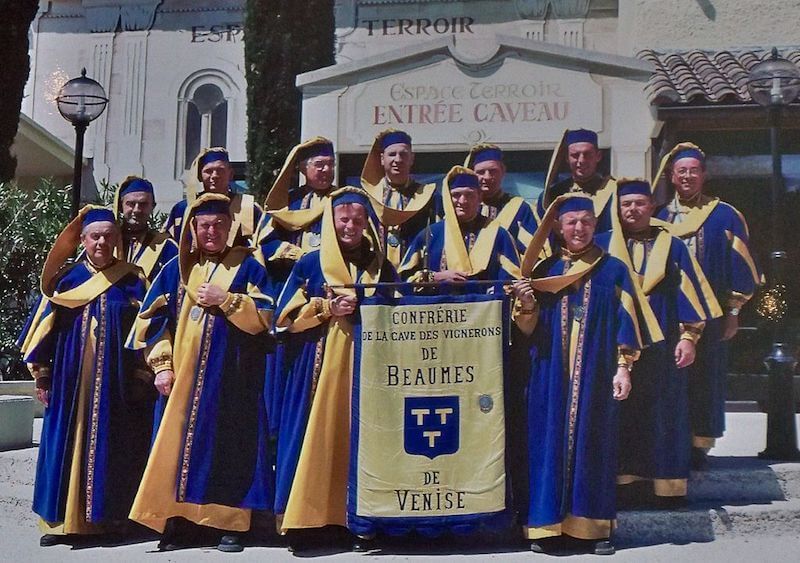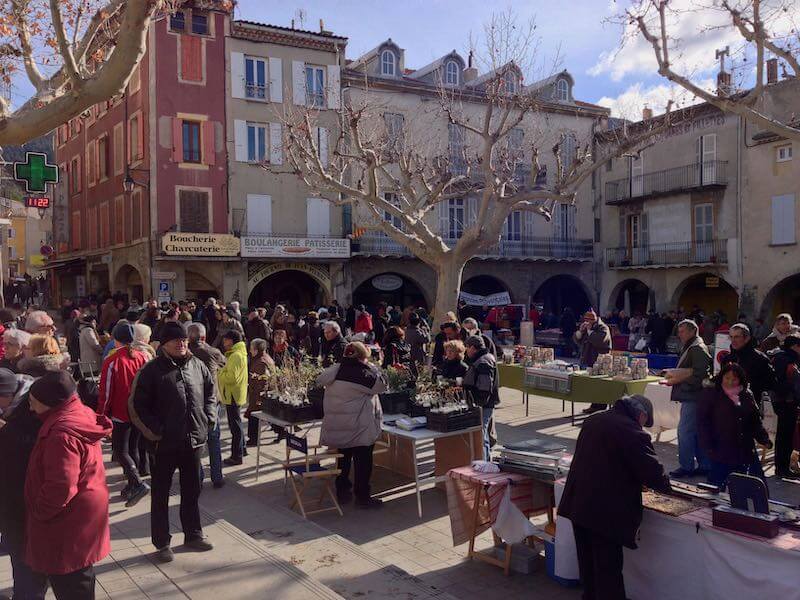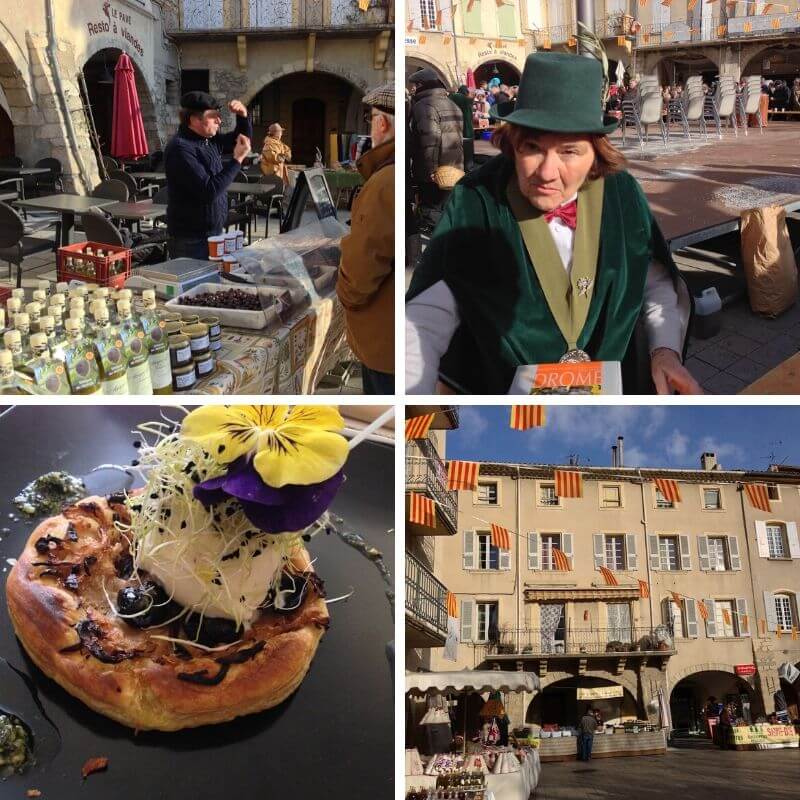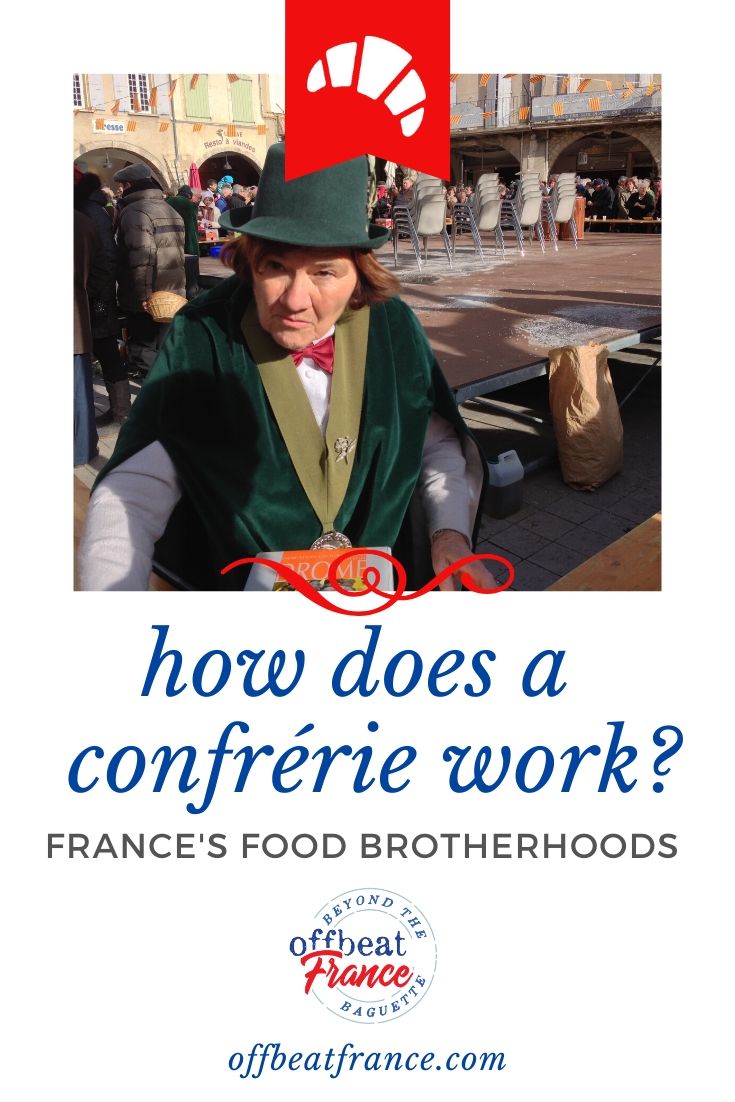Unsure about your French table manners? Click Here to download > > How to avoid these 10 food etiquette mistakes !
- Home ›
- Ze French ›
- La Gastronomie ›
- Food Brotherhoods of France
France's Unusual Brotherhoods of Food and Wine
Updated 23 April 2025 by Leyla Alyanak — Parisian by birth, Lyonnaise by adoption, historian by passion
You'd be forgiven for thinking you’re witnessing a secret society. Robes. Staffs. An austere Grand Master. All that's missing is a secret handshake.
But when these men — and they are often mostly men — swear allegiance, it’s not to a god or moral code. It’s to brie. Or garlic. Or wine.
These are the confréries of France, the 1500 or so ancient brotherhoods born of medieval guilds and now dedicated to promoting regional delicacies, France's produits du terroir, which loosely translates as local products.
 Typical pose at a gathering of a confrérie. Here, the Confrérie des Beaumes de Venise, a Rhône Valley wine, celebrate their product Véronique PAGNIER / Public domain
Typical pose at a gathering of a confrérie. Here, the Confrérie des Beaumes de Venise, a Rhône Valley wine, celebrate their product Véronique PAGNIER / Public domainOlives, Olive Oils and the Brotherhood of the Olive Tree
I first came across these brotherhoods on a visit to Nyons (pronounce nee-owns), in the lavender land that straddles the border between Rhône-Alpes and Provence. Nestled at the edge of the Drôme département, Nyons is the proud home of La Tanche, a dark brown olive you won’t find anywhere else.
Draped in green velvet capes and felt hats, the representatives of this particular brotherhood were here to promote La Tanche.
 Lined up along wooden tables, extolling the virtues of this olive (and olives in general), the members of the Knights of the Olive Tree spent a bright winter day in good cheer, surrounded by admirers and amateurs.
Lined up along wooden tables, extolling the virtues of this olive (and olives in general), the members of the Knights of the Olive Tree spent a bright winter day in good cheer, surrounded by admirers and amateurs.Promoters caught on to their growing popularity and the first Fête de l’Alicoque was born, celebrating the year’s first harvest, the huile nouvelle, just like wine celebrates the Beaujolais Nouveau.
I arrived in Nyons just in time for the festival, which has been going on for more than three decades, buffeted by wild February winds that pierced my skin much as a Canadian winter might. The sun, high in the sky, reminded me we weren’t that far from the Mediterranean and that yes, olives could grow and prosper here as they since the dawn of humanity.
The Alicoque
The Alicoque is typical of these deeply French affairs – a foot race, a chorus, musicians, guided visits, traditional dance, and of course, a tasting, during which hundreds of enthusiasts jostle for a place at the long table to taste the New Oil, drizzled over dried croutons (don’t forget to rub them with a piece of garlic first) and chased down with copious amounts of wine.
At attention behind the table, a few dozen men (and a handful of women) in olive green capes and felt hats serve citizens and hold court, like members of some long-forgotten lodge, replete with oaths and Grand Masters and initiation rites involving an olive branch. This is the Confrérie des Chevaliers de l’Olivier, or Brotherhood of the Knights of the Olive Tree, whose sworn duty is to protect the olive tree.
Madame Laget is a vivacious olive grove owner who feels right at home at the festival. “There aren’t many women in the Confrérie,” she said proudly, “and I’m one of only five women who is allowed to wear the green cape.”
As traditional as the costumes look, this Confrérie, or brotherhood, is relatively new, created a mere half-century ago in response to the devastating freeze of 1956, which killed two-thirds of France’s olive trees and put many farmers and producers out of business. The brotherhood helped put olives and olive oil back on the map, much like other confréries have done for their products.
What really matters is the product
Today I was ready to be set straight, although tasting pure olive oil out of a small plastic spoon isn’t what I’d call a gastronomic delight. Still, the tasting is a necessary path to understanding the subtleties of a product so proudly promoted throughout the Mediterranean.
“Olive oil has been extracted the same way for 5,000 years: the olives are crushed, and the paste is pressed to get the oil. What has changed are the tools used to do this,” said Alexandra Paris, a spokesperson for the AFIDOL, the French professional olive association set up to improve and promote French olive oils.
“Fifty or sixty years ago production methods were different, we used a fiber scourtin to press the oil, and storage and quantities meant the taste of olive oils was more pungent, stronger. It marked entire generations and in France we want to preserve this taste, which you’ll find nowhere else.”
While the Nyons variety is classified as Subtle, I also ventured into Intense and even Old Fashioned, like grandmother’s, I was told. The oils did taste nutty as promised, but also like apples, like grass, and one even tasted of rocket, sweet on the tip of my tongue and increasingly sour and tart as the taste rolled down my throat. Another left a buttery aftertaste which took several swigs of water to eliminate.
Surprisingly, the olive oils didn’t smell the way they tasted.
Apparently the taste is influenced by the region, the type of olive, their maturity and the extraction method, quite a palette of factors. No wonder there are more than 1000 varieties of olive oil worldwide.
As I walked around Nyons I found it everywhere, on tables to spread on bread, or in soups, as an ethereal thread clinging tenaciously to the surface.
 Clockwise from upper left: oil-based products for sale in Nyons, Madame Laget of the brotherhood, a vista of the main square of Nyons, one of the many olive-based dishes available in restaurants during the Alicoque
Clockwise from upper left: oil-based products for sale in Nyons, Madame Laget of the brotherhood, a vista of the main square of Nyons, one of the many olive-based dishes available in restaurants during the AlicoqueIn France olive oil has its own cultural touchstone. In his poem Les Olivades, Nobel-prizewinning poet Frederic Mistral immortalizes the olive tree and speaks of offerings of virgin oil on the altar.
Olive oil, or liquid gold, as some would like to call it, is of course a food condiment, used for cooking but also as a flavoring, poured lightly on salad or potatoes or pretty much anything. It also has other, more surprising uses, from burning it for light, using it in religious ceremonies and as a skin moisturizer, furniture polish, hair conditioner, lice treatment, hairball preventer, and, dribbled warm, a cure for earaches.
In Ancient Greece, athletes rubbed it on their bodies to protect their skins and give their bulging muscles a sheen. It was also a healer, which Hippocrates, the Father of Medicine, said could heal many ailments including so-called “diseases of women.”
If Athena were to come back for a visit, she might be surprised to see some of the results of her little gift. I mean, olive jam? Olive, verbena and marshmallow ice cream?
But I digress, led astray by my culinary enthusiasm. Back to the brotherhoods.
Are food brotherhoods just for show?
From afar, all this regalia may seem like quaint folklore—velvet robes, oversized medallions, ritual oaths. But dig a little deeper and these brotherhoods take on a different hue. They act as guardians of regional identity, keeping old recipes alive, boosting struggling local economies, and offering cultural continuity in a world obsessed with the new. They may look like a pageant, but their mission often runs deeper than it appears.
The inner workings of a confrérie
By swearing this allegiance, adherents promise a number of things, the foremost being the promotion of the product they represent.
These brotherhoods can gain plenty of influence, hosting presidents and politicians, especially if they represent a valuable product. Often, they include in their ranks local dignitaries, food and wine specialists, or local politicians.
They come in all sizes and shapes. In food, you'll find the brotherhood of the Chocolatine (pain au chocolat), of pink garlic, of the Carpentras strawberry, of the Burgundy snail, of brie or camembert... and I could go on and on, not to mention all the brotherhoods representing wine.
France even has a charter that governs these brotherhoods and includes such obligations as remaining apolitical and non-discriminatory, obeying laws, transmitting knowledge and acting as ambassadors for their various products. An interesting clause involves not falling into a "grotesque folklore", reflecting instead a certain art, seriousness and quality.
Throughout the year, brotherhoods hold their own meetings but in summer, they often come together with other brotherhoods, especially at festivals like the Alicoque. They may also gather along food types, or regionally, or even hold get-togethers with brethren in Belgium, Spain or Italy!
Photo credit top: Castelnaudary Tourisme
Curious about the rituals, the secrecy, and the strange mix of devotion and performance?
In this free Substack post, I take you behind the velvet curtains of France’s food and wine brotherhoods — where tradition meets theater, and garlic gets a guard of honor.
Did you enjoy this article? I'd love if you shared it!




